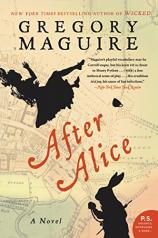After Alice
Review
After Alice
Gregory Maguire has made something of a career of taking a fresh (and very grownup) look at classic children’s literature, often giving once-minor characters new voices and places of prominence. Of course, there’s WICKED and its sequels based on THE WIZARD OF OZ, but there’s also CONFESSIONS OF AN UGLY STEPSISTER, MATCHLESS and others adapted from fairy tales like “Cinderella” and “The Little Match Girl.” Now, in AFTER ALICE, Maguire encourages readers to follow him down the rabbit hole in his new exploration of ALICE’S ADVENTURES IN WONDERLAND.
As in his previous books, Maguire chooses to focus on two characters whose roles in the original are minor at best: Alice’s older sister, Lydia (the one who was reading a tiresome book by the river when Alice caught sight of the white rabbit), and Alice’s friend and neighbor, Ada. In Maguire’s version, Alice is essentially offstage for nearly the entire novel; instead, he focuses on these two other girls and what Alice’s disappearance means for them.
"Maguire alternates locations by chapter, which offers plenty of opportunity for interesting parallels between the two worlds.... AFTER ALICE will inspire readers to think anew about both historical realities and classic fantasies."
Ada is an unattractive child, heavyset and suffering from scoliosis. When she follows Alice down the rabbit hole, she is first struck by the feeling of freedom when her corset and back brace fall away from her, leaving her free to explore this new world unencumbered by her earthly limitations. Back in the “real world,” Lydia is vaguely annoyed by Alice’s latest antics (one gets the impression that Alice may be in the habit of disappearing for long stretches of time) but also intrigued by the house guests who are demanding her father’s attention at their Oxford home. These include Charles Darwin, as well as an abolitionist from the United States, Josiah Winter, and the young black boy, Siam, who accompanies him.
Siam eventually joins Ada in Wonderland, and their attempts to find Alice’s whereabouts grow, in the words of Lewis Carroll, “curiouser and curiouser.” Maguire’s version of Wonderland is populated with many familiar characters (the Mad Hatter and March Hare, the Queen of Hearts, the Cheshire Cat and the rest), as well as some new Wonderland denizens of his own devising. It’s diverting to see Maguire offer non sequiturs, riddles and wordplay to rival Carroll’s own, but ultimately what makes AFTER ALICE a truly original and modern novel is the interplay between the “real world” that Lydia inhabits and the Wonderland that Ada, Siam and (perhaps) Alice are investigating.
Maguire alternates locations by chapter, which offers plenty of opportunity for interesting parallels between the two worlds. Eventually, what becomes clear is that Maguire’s Wonderland is in many ways a commentary on what it must have been like to be living in the 1860s, in a world in which scientific notions like evolution, social movements like abolition, and advances in industry and scholarship of all kinds left the average resident of the “real world” feeling unmoored, disoriented and downright perplexed --- kind of like Alice in Wonderland. There are many other reasons to enjoy the oblique interaction between the historical sections and the fantastical ones, particularly the many references to “falling” and the “underworld,” from classical mythology to Darwin’s own “descent of man.”
AFTER ALICE will inspire readers to think anew about both historical realities and classic fantasies.
Reviewed by Norah Piehl on October 29, 2015





